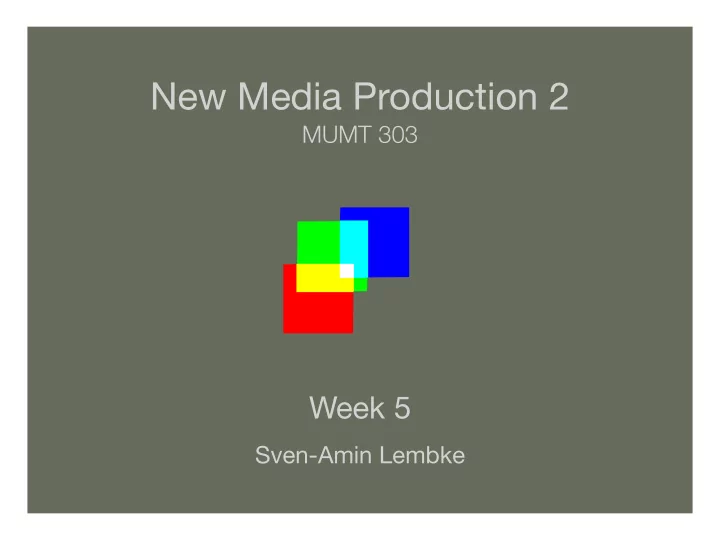

New Media Production 2 MUMT 303 Week 5 Sven-Amin Lembke
Hildegard Westerkamp (1946-)
Hildegard Westerkamp • German/Canadian composer • member of World Soundscape Project • known for promoting soundwalks ‣ auditory exploration of environments ‣ experience “uncompromising listening” ‣ key aspect of soundscape studies is the sensitization to acoustic surroundings ‣ serves development of listening skills
Hildegard Westerkamp • soundwalks • motivation: modern, urban life has lost touch with listening to environmental sounds • developing aural awareness ... ‣ conscious, attentive listening ‣ assess if soundscape out of balance "Wherever we go we will give our ears priority . They have been neglected by us for a long time and, as a result, we have done little to develop an acoustic environment of good quality ."
Hildegard Westerkamp • soundwalks • besides standard walks ... ‣ participatory soundwalks ‣ soundwalk composition ‣ example: Kits Beach Soundwalk 1987 • contemporary interpretations ... ‣ virtual soundwalk on soundscape mapping project radio aporee ::: maps ‣ electrical walk by sound-artist Christina Kubisch, exploring electromagnetic environments
Luigi Russolo (1885-1947)
Luigi Russolo • Italian painter and composer • member of Italian Futurism ‣ Futurist themes: speed, power, noise • The Art of Noises: Futurist Manifesto 1913 ‣ highly influential in 20th century discussion of musical aesthetics ‣ inspired Pierre Schaeffer, Francisco López, The Art of Noise, Einstürzende Neubauten, DJ Spooky ‣ written as a letter to his friend and Futurist composer Francesco Balilla Pratella
Luigi Russolo • The Art of Noises: Futurist Manifesto • through increasing industrialization and mechanization noise characterized late-19th and 20th centuries • music needs to extend its vocabulary towards embracing noises "We must break out of this limited circle of sounds and conquer the infinite variety of noise-sounds."
Luigi Russolo • The Art of Noises: Futurist Manifesto • six families of noises 1. roars, thundering, explosions, hissing roars, booms 2. whistling, hissing, puffing 3. whispers, murmurs, mumbling, muttering, gurgling 4. screeching, creaking, rustling, humming, cracking, rubbing 5. noises obtained by hitting on metals, woods, skins, stones, pottery 6. voices of animals and humans: shouts, screams, shrieks, wails, hoots, howls, death rattles, sobs
Luigi Russolo • Intonarumori 1913 ‣ “noise instruments”
Luigi Russolo • Intonarumori 1913 ‣ “noise instruments” ‣ d ‣ example: Risveglio Di Una Città 1913
Luigi Russolo • The Art of Noises: Futurist Manifesto • conclusions drawn ... ‣ noises replace sounds ‣ noise yields infinite variety of timbres ‣ end to traditional and facile rhythms with random nature of noise ‣ "predominant general pitch" ‣ orchestra of noises
Luigi Russolo • The Art of Noises: Futurist Manifesto "Let us go together, like futurists, into one of these hospitals for anemic sounds . There—the first beat brings to your ear the weariness of something heard before, and makes you anticipate the boredom of the beat that follows . So let us drink in, from beat to beat, these few qualities of obvious tedium, always waiting for that extraordinary sensation that never comes."
Luigi Russolo • The Art of Noises: Futurist Manifesto • Reception by other musicians, e.g. ... • Edgard Varèse ‣ embraced noise and ‘sound masses’ • Henry Cowell ‣ argued for music and noise not being mutually exclusive • Morton Feldman ‣ “Sound is all our dreams of music. Noise is music’s dream of us.”
Trevor Wishart (1946-)
Trevor Wishart • English composer • worked at IRCAM, Paris in 1980s • studied composition at GRM in 1993 • developer of numerous sound manipulating procedures: ‣ spectral, temporal and textural transformations ‣ called them ‘musical instruments’ • founded Composers’ Desktop Project (CDP) ‣ development of own computer system ‣ book Audible Design 1994
Trevor Wishart • Works: • Red Bird 1977 ‣ analog piece, experimenting with available resources in studio, e.g. tape editing, mixing, equalization ‣ use of speech fragments to mimic other sounds • Vox 5 1986 ‣ usage of phase vocoder employing wide range of spectral manipulations, e.g. morphing ‣ extensive use of texture manipulation
Trevor Wishart • Spectral transformations ‣ morphing ‣ freezing ‣ shifting ‣ cleaning ‣ banding, e.g. tracing or blurring ‣ arpeggiation ‣ interleaving ‣ tuning ‣ pitch manipulation
Trevor Wishart • Spectral transformations original spectrum spectral freezing spectral blurring
Trevor Wishart • Spectral transformations original spectrum spectral tracing spectral masking
Trevor Wishart • Time-domain instruments • waveset distortion ‣ techniques: replacement, average, repetition • sound-shredding • envelope manipulation • grain manipulation • example: Tongues of Fire 1994 ‣ employed waveset distortion, sound shredding, envelope manipulation
Trevor Wishart • Grain manipulation ‣ based on granular synthesis approach ‣ useful for iterative sounds, i.e. sounds exhibiting repeated attacks ‣ realistic time-stretch and -compression for iterative sounds ‣ more natural reversal of iterative sounds ‣ artificial renderings through resynthesis of limited set of grains or manipulated in pitch, amplitude or timing
Trevor Wishart • Texture manipulation • texture created by generation of event streams • generation through higher-level control of parameters ‣ density ‣ scatter ‣ quantization ‣ input selection ‣ range and range-limits for pitch, amplitude, duration ‣ stereo center and width
Trevor Wishart • Brassage • segmentation of sounds into little slices and redistributing/rearranging them • term established by GRM • segment controllable in respect to ... ‣ density ‣ size ‣ transposition and amplitude ‣ spatial position and scatter ‣ timing ‣ region in source
Recommend
More recommend